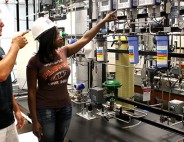Michigan’s Comeback Kicks In
20 Feb, 2014
By David Hodes
Michigan may have been quite during the last few years; however, this former economic powerhouse has recharged and is surging ahead with diverse business offerings that are growing the state’s economy once again.
Mike Finney, president and CEO of the Michigan Economic Development Corp. (MEDC) says that one of the economic development programs that “is a real sleeper for most states” is the potential for companies to do business with each other. The state has such a program now: the Pure Michigan Business Connect, launched three years ago by Gov. Rick Snyder and the MEDC with more than $1.5 billion of business-to-business activity recorded in 2013.
Pure Michigan Business Connect is a multibillion dollar public/private initiative that introduces Michigan businesses into the purchasing pipelines of the state’s larger companies. Through this network, Michigan companies are encouraged to increase their procurement spending within the state.
Professional assistance is available to small businesses and startups at little or no charge, including legal, accounting, web development and human resource assistance. “We are forecasting this program to grow to about $8 billion of business-to-business activity over a five year period,” Finney says.
Another incentive program is the Michigan Business Development (MBD) program, created in 2011from the Michigan Strategic Fund in cooperation with the MEDC. The program is designed to provide grants, loans or other economic assistance to businesses for highly competitive projects in the state that create jobs and provide investment. Already more than 125 companies have taken advantage of this incentive program.
One recent innovative collaborative program between the MEDC, the nonprofit economic development organization The Right Place Inc., and the Vergennes Township is an MBD program performance-based grant of $175,000 for South Carolina-based Industrial Services Group (ISG).
ISG is expanding its engineered composite solutions manufacturing operations in Vergennes, investing $1.63 million in building renovations and equipment, and adding 50 new jobs.
Industries and Innovations
Michigan has always had a manufacturing-heavy base, represented by the huge automotive industry that has been resurging during the last few years. One of those resurging companies is one of the country’s iconic businesses: General Motors.
General Motors announced a major expansion last year. The company will invest $200 million into its global powertrain engineering headquarters in Pontiac to build a new 138,000- square-foot test wing, which is expected to be completed during the second half of 2014.
The plan is part of GM’s previously announced commitment to invest $1.5 billion in its North American facilities in 2013.
One of the other growing manufacturing sectors in the state is medical devices, represented by companies such as Stryker Corp., with its world headquarters in Kalamazoo. It is a major player in the manufacturing of medical, surgical and neurotechnology devices.
Another growing medical device company is Tokyo-based Terumo Cardiovascular Systems (Terumo CVS) in Ann Arbor. In 2010, the company brought 65 new jobs and $3.5 million in capital investments to its Ann Arbor location as a result of an incentive program offered by the MEDC. Terumo CVS develops and manufactures a highly specialized line of intraoperative monitoring products.
Those operations were moved to Ann Arbor where Terumo CVS already manufactures electromechanical devices — including its market-leading line of heart-lung machines — and a line of sterile products. “The interesting thing is that, during their major growth spurt over the last four or five years, Terumo hired the talent pool from automotive,” Finney says. “Because many of the exact tools used in automotive manufacturing are used in making medical devices, such as the heart-lung machine.”
One of the larger medical devices suppliers is PTI Engineered Plastics, a plastic injection molding services manufacturer in Macomb County, part of the Detroit metropolitan area. PTI was originally created for automotive manufacturing; it is now doing work in medical devices along with other work for the Department of Defense. “We are starting to see that many of these automotive manufacturing companies have redesigned and retooled themselves,” says Mark Hackel, county executive with the Macomb County Department of Planning and Economic Development (MCDPED).
Hackel says that there were about $30 billion in defense contracts awarded in Macomb, representing about 60 percent of all the defense contracts awarded to the state. There are 600 companies that do work in the county — including General Dynamics Land Systems, the defense industry’s largest supplier of armored military vehicles — and about 1,600 companies in the state that do defense-related work.
“My intention is to figure out not only strategically what we are, but how we grow that cluster into becoming the capital of the world,” Hackel says.
In Grand Rapids, in the western part of the state 25 miles from Lake Michigan, Therese Thill, vice president of business development for The Right Place, says that the organization just finished the year with 18 projects underway. “We broke our goals twice,” she says. “And it’s really about diversity — everything from automotive to food processing to smaller IT shops.”
Food processing is one of the industries few outside of the state consider when thinking about Michigan’s economic engines. One of the bigger food processing news events concerned the Spartan Nash merger. Spartan Stores, Inc., a family-owned chain headquartered in Byron Township for 150 years distributes national brands to more than 400 independent grocery stores in Michigan, Indiana and Ohio. Nash Finch Co., based out of Minnesota, does procurement for the federal government and military. It is the second-largest publicly traded wholesale food distributor in the country.
The Right Place, in collaboration with the MEDC and Byron Township, announced the approval last November of $2.75 million in total economic incentives for the newly merged SpartanNash Co., which is headquartered in Byron Township.
Down to Business
*Michigan has one of the richest talent pools in the country. The state’s high-tech workforce is the fourth largest in the country with more than 87,000 engineers, 70,000 R&D professionals and 75,000 skilled tradespeople.
*In the last four years more than 200,000 new jobs were created in the state and today, more than 50 percent of recent graduates choose to remain in the state.
*Michigan’s growth rate is the sixth best in the country. Indicators include economic activity at a 10-year high; gross state product projected at $340 billion; and exports projected to reach $3.27 billion this year.
Talent and Education
Finney says that the state has one of the deepest knowledge pools that can be found when it comes to manufacturing. “And I think everything starts with talent,” he says. “I think talent is the new currency in economic development.”
He highlights the Michigan Advanced Technician Training program, or MAT2. It is a three-year, no-cost program for high school seniors graduating this year. It provides hands-on experience in an in-demand field and can lead to an associate degree.
Apprentice employees earn money while employers gain a skilled worker. Programs are offered for mechatronics engineers, IT engineers, and design and visualization technicians for working on applications like 3D modeling.
The program is currently being offered through four community colleges — Henry Ford Community College in Dearborn, Macomb Community College in Warren, Mott Community College in Flint, and Oakland Community College in Oakland County — that have the industry-approved facilities and equipment for this highly specialized training.
Finney says that, for a while, Michigan was not seen as the coolest place to be for young engineers. “But look at automotive now,” he says. “Cars are some of the most technologically advanced products that we have in our society, with all that software embedded in them. So young people who have traditionally steered away from automotive manufacturing are now finding it interesting.”
Assets
The state, which already features some of the busiest cross-border highway connections to Canada, is building another bridge that connects Detroit to Windsor, Ontario, Canada to supplement that busy border crossing. The new, six-lane bridge, announced in April 2013, will be built roughly parallel to the existing Ambassador Bridge. “We are looking to add to that and see incredible amounts of additional opportunities by linking the core of Michigan to the northeast part of North America with some of the deepest ports in Canada,” Finney says.
The Ambassador Bridge, along with the new bridge just now under construction, plus the Blue Water Bridge in Port Huron, are key elements of a plan to make Detroit a stronger logistics hub. Both bridges allow access to the Halifax, Nova Scotia, Canada deep-water port and three other deep-water ports along the St. Clair River. It is part of a growing logistics strategy that also takes advantage of access to the Canadian National Railway in Port Huron.
Outdoors and Recreation
Condé Nast Traveler named the Lake Michigan shoreline one of the 25 best in the world. MTV ranks Oval Beach, with a mile of waterfront beach in Saugatuck, as one the five most beautiful in the United States. Visitors looking for cool beaches can also spend time at the 189-acre Lake Harbor Park, on Norton Shores; the 13-acre Grand Haven City Beach, in Grand Haven; or the 7-acre North Beach Park in Spring Lake.
Lifestyle
Hackel says the state’s lifestyle is a major attraction for growing or expanding businesses. “People like to live in a place that is not only welcoming but a place where they feel comfortable,” he says.
In Macomb County, they have Lake St. Clair as an asset for a comfortable lifestyle — a 430-square-mile fresh water lake that is six miles northeast of downtown Detroit. “With our water asset, we think there is tremendous opportunity to grow the quality of life, including the recreational assets,” Hackel says. “And we are very focused on that.”
When people move to the state, it’s not always about the incentives, says Stephen Cassin, executive director of the MCDPED. “Incentives come into play less often than you think,” he says. “It’s more about being closer to their suppliers, being closer to other industries that they serve, and it’s the quality of life.”
But there is still so much more that the state needs to work on — things to build in a state that builds things — to continue to prove that Michigan is the comeback king in economic development.
Thill says that she would like to see the diversity of their industries grow. “That is our silent strength, that’s what we want,” she says. “And that diversity brings back the young people, which is going to keep Grand Rapids and the whole state growing into the future.”
More Info
Michigan Economic Development Corp.
Macomb County Department of Planning and Economic Development
Illustration by twobee at Free Digital Photos.net
Related Posts
-

Business Starts Here
-

TEXAS ENTERS 2021 AS WORLD’S 9TH LARGEST ECONOMY BY GDP
-

CALIFORNIA: 5TH LARGEST ECONOMY IN THE WORLD
-

MINNESOTA: FIRST IN FIVE-YEAR BUSINESS SURVIVAL RATE
-

CANADA: Alberta. More Open Than Ever
-

KENTUCKY: The Bluegrass State Is The Right Place To Grow Your Business
-

TENNESSEE: Great Brands Deserve the Great State of Tennessee
-

LOUISIANA: Custom Workforce for Expanding
-

MARYLAND: Home of Innovators
-

MAINE: Yankee Ingenuity









